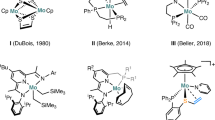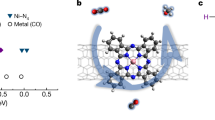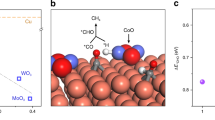Abstract
Carbon dioxide is the ultimate source of the fossil fuels that are both central to modern life and problematic: their use increases atmospheric levels of greenhouse gases, and their availability is geopolitically constrained1. Using carbon dioxide as a feedstock to produce synthetic fuels might, in principle, alleviate these concerns. Although many homogeneous and heterogeneous catalysts convert carbon dioxide to carbon monoxide2, further deoxygenative coupling of carbon monoxide to generate useful multicarbon products is challenging3. Molybdenum and vanadium nitrogenases are capable of converting carbon monoxide into hydrocarbons under mild conditions, using discrete electron and proton sources4. Electrocatalytic reduction of carbon monoxide on copper catalysts5 also uses a combination of electrons and protons, while the industrial Fischer–Tropsch process uses dihydrogen as a combined source of electrons and electrophiles for carbon monoxide coupling at high temperatures and pressures6. However, these enzymatic and heterogeneous systems are difficult to probe mechanistically. Molecular catalysts have been studied extensively6,7,8,9,10,11,12,13,14,15,16,17,18,19,20,21,22,23 to investigate the elementary steps by which carbon monoxide is deoxygenated and coupled, but a single metal site that can efficiently induce the required scission of carbon–oxygen bonds and generate carbon–carbon bonds has not yet been documented. Here we describe a molybdenum compound, supported by a terphenyl–diphosphine ligand, that activates and cleaves the strong carbon–oxygen bond of carbon monoxide, enacts carbon–carbon coupling, and spontaneously dissociates the resulting fragment. This complex four-electron transformation is enabled by the terphenyl–diphosphine ligand24,25, which acts as an electron reservoir and exhibits the coordinative flexibility needed to stabilize the different intermediates involved in the overall reaction sequence. We anticipate that these design elements might help in the development of efficient catalysts for converting carbon monoxide to chemical fuels, and should prove useful in the broader context of performing complex multi-electron transformations at a single metal site.
This is a preview of subscription content, access via your institution
Access options
Subscribe to this journal
Receive 51 print issues and online access
$199.00 per year
only $3.90 per issue
Buy this article
- Purchase on Springer Link
- Instant access to full article PDF
Prices may be subject to local taxes which are calculated during checkout



Similar content being viewed by others
References
Appel, A. M. et al. Frontiers, opportunities, and challenges in biochemical and chemical catalysis of CO2 fixation. Chem. Rev. 113, 6621–6658 (2013)
Costentin, C., Robert, M. & Saveant, J.-M. Catalysis of the electrochemical reduction of carbon dioxide. Chem. Soc. Rev. 42, 2423–2436 (2013)
Gattrell, M., Gupta, N. & Co, A. A review of the aqueous electrochemical reduction of CO2 to hydrocarbons at copper. J. Electroanal. Chem. 594, 1–19 (2006)
Hu, Y. L., Lee, C. C. & Ribbe, M. W. Extending the carbon chain: hydrocarbon formation catalyzed by vanadium/molybdenum nitrogenases. Science 333, 753–755 (2011)
Li, C. W., Ciston, J. & Kanan, M. W. Electroreduction of carbon monoxide to liquid fuel on oxide-derived nanocrystalline copper. Nature 508, 504–507 (2014)
West, N. M., Miller, A. J. M., Labinger, J. A. & Bercaw, J. E. Homogeneous syngas conversion. Coord. Chem. Rev. 255, 881–898 (2011)
Gardner, B. M. et al. Homologation and functionalization of carbon monoxide by a recyclable uranium complex. Proc. Natl Acad. Sci. USA 109, 9265–9270 (2012)
Summerscales, O. T., Cloke, F. G. N., Hitchcock, P. B., Green, J. C. & Hazari, N. Reductive cyclotrimerization of carbon monoxide to the deltate dianion by an organometallic uranium complex. Science 311, 829–831 (2006)
Miller, R. L., Wolczanski, P. T. & Rheingold, A. L. Carbide formation via carbon monoxide dissociation across a tungsten-tungsten triple bond. J. Am. Chem. Soc. 115, 10422–10423 (1993)
LaPointe, R. E., Wolczanski, P. T. & Mitchell, J. F. Carbon monoxide cleavage by (silox)3Ta (silox = tert-Bu3SiO-). J. Am. Chem. Soc. 108, 6382–6384 (1986)
Evans, W. J., Grate, J. W., Hughes, L. A., Zhang, H. & Atwood, J. L. Reductive homologation of carbon monoxide to a ketenecarboxylate by a low-valent organolanthanide complex: synthesis and x-ray crystal structure of [(C5Me5)4Sm2(O2CCCO)(THF)]2 . J. Am. Chem. Soc. 107, 3728–3730 (1985)
Ballmann, J., Pick, F., Castro, L., Fryzuk, M. D. & Maron, L. Cleavage of carbon monoxide promoted by a dinuclear tantalum tetrahydride complex. Organometallics 31, 8516–8524 (2012)
Watanabe, T., Ishida, Y., Matsuo, T. & Kawaguchi, H. Reductive coupling of six carbon monoxides by a ditantalum hydride complex. J. Am. Chem. Soc. 131, 3474–3475 (2009)
Shima, T. & Hou, Z. Hydrogenation of carbon monoxide by tetranuclear rare earth metal polyhydrido complexes. Selective formation of ethylene and isolation of well-defined polyoxo rare earth metal clusters. J. Am. Chem. Soc. 128, 8124–8125 (2006)
Matsuo, T. & Kawaguchi, H. A synthetic cycle for H2/CO activation and allene synthesis using recyclable zirconium complexes. J. Am. Chem. Soc. 127, 17198–17199 (2005)
Belmonte, P. A., Cloke, F. G. N. & Schrock, R. R. Reduction of carbon monoxide by binuclear tantalum hydride complexes. J. Am. Chem. Soc. 105, 2643–2650 (1983)
Carnahan, E. M., Protasiewicz, J. D. & Lippard, S. J. 15 years of reductive coupling—what have we learned? Acc. Chem. Res. 26, 90–97 (1993)
Büchner, W. & Weiss, E. Zur kenntnis sogenannten alkalicarbonyle 4 uber reaktion von geschmolzenem kalium mit kohlenmonoxid. Helv. Chim. Acta 47, 1415–1423 (1964)
Wayland, B. B., Sherry, A. E. & Coffin, V. L. Selective reductive coupling of carbon-monoxide. J. Chem. Soc. Chem. Commun. 662–663 (1989)
Suess, D. L. M. & Peters, J. C. A CO-derived iron dicarbyne that releases olefin upon hydrogenation. J. Am. Chem. Soc. 135, 12580–12583 (2013)
Peters, J. C., Odom, A. L. & Cummins, C. C. A terminal molybdenum carbide prepared by methylidyne deprotonation. Chem. Commun. 1995–1996 (1997)
Kreissl, F. R., Frank, A., Schubert, U., Lindner, T. L. & Huttner, G. Carbonyl-η-cyclopentadienyl-(4-methylphenylketenyl)-bis(trimethylphosphane)tungsten—a novel, stable transition metal-substituted ketene. Angew. Chem. Int. Edn 15, 632–633 (1976)
Churchill, M. R., Wasserman, H. J., Holmes, S. J. & Schrock, R. R. Coupling of methylidyne and carbonyl ligands on tungsten. Crystal structure of W(η2-HC≡COAlCl3)(CO)(PMe3)3Cl. Organometallics 1, 766–768 (1982)
Buss, J. A., Edouard, G. A., Cheng, C., Shi, J. & Agapie, T. Molybdenum catalyzed ammonia borane dehydrogenation: oxidation state specific mechanisms. J. Am. Chem. Soc. 136, 11272–11275 (2014)
Horak, K. T., Velian, A., Day, M. W. & Agapie, T. Arene non-innocence in dinuclear complexes of Fe, Co, and Ni supported by a para-terphenyl diphosphine. Chem. Commun. 50, 4427–4429 (2014)
Cassani, M. C., Gun’ko, Y. K., Hitchcock, P. B., Lappert, M. F. & Laschi, F. Synthesis and characterization of organolanthanidocene(III) (Ln = La, Ce, Pr, Nd) complexes containing the 1,4-cyclohexa-2,5-dienyl ligand (benzene 1,4-dianion): structures of [K([18]-crown-6)][Ln{η5-C5H3(SiMe3)2-1,3}2(C6H6)] [Cp′′ = η5-C5H3(SiMe3)2-1,3; Ln = La, Ce, Nd]. Organometallics 18, 5539–5547 (1999)
Ellis, J. E. Adventures with substances containing metals in negative oxidation states. Inorg. Chem. 45, 3167–3186 (2006)
Enriquez, A. E., White, P. S. & Templeton, J. L. Reactions of an amphoteric terminal tungsten methylidyne complex. J. Am. Chem. Soc. 123, 4992–5002 (2001)
Carlson, R. G. et al. The metathesis-facilitated synthesis of terminal ruthenium carbide complexes: a unique carbon atom transfer reaction. J. Am. Chem. Soc. 124, 1580–1581 (2002)
Stewart, M. H., Johnson, M. J. A. & Kampf, J. W. Terminal carbido complexes of osmium: synthesis, structure, and reactivity comparison to the ruthenium analogues. Organometallics 26, 5102–5110 (2007)
Acknowledgements
We thank L. M. Henling and M. K. Takase for crystallographic assistance and D. VanderVelde for NMR expertise. We are grateful to Caltech and the National Science Foundation (grant CHE-1151918 to T.A., and GRFP to J.A.B.) for funding.
Author information
Authors and Affiliations
Contributions
J.A.B. and T.A. designed the research. J.A.B. conducted the experiments. J.A.B. and T.A. interpreted the data and wrote the manuscript.
Corresponding author
Ethics declarations
Competing interests
The authors declare no competing financial interests.
Supplementary information
41586_2016_BFnature16154_MOESM254_ESM.pdf
This file contains Supplementary Text and Data, Supplementary Figures 1-28, Supplementary Tables 1-2, and additional references. Further information on the synthesis and characterization of the compounds and intermediates investigated in this study are detailed. (PDF 3812 kb)
Supplementary Data 1
This file contains the Source Data for Supplementary Figure 21. (XLSX 161 kb)
Supplementary Data 2
This file contains the Source Data for Supplementary Figure 22. (XLSX 85 kb)
Source data
Rights and permissions
About this article
Cite this article
Buss, J., Agapie, T. Four-electron deoxygenative reductive coupling of carbon monoxide at a single metal site. Nature 529, 72–75 (2016). https://doi.org/10.1038/nature16154
Received:
Accepted:
Published:
Issue Date:
DOI: https://doi.org/10.1038/nature16154
This article is cited by
-
Supramolecular tuning of supported metal phthalocyanine catalysts for hydrogen peroxide electrosynthesis
Nature Catalysis (2023)
-
Selective reduction and homologation of carbon monoxide by organometallic iron complexes
Nature Communications (2018)
-
Carbon oxygenate transformations by actinide compounds and catalysts
Nature Reviews Chemistry (2017)
Comments
By submitting a comment you agree to abide by our Terms and Community Guidelines. If you find something abusive or that does not comply with our terms or guidelines please flag it as inappropriate.



